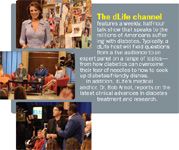Alternative Media: TV's Targeted Comeback
Consumers don't want scheduled media; they want to control their TV programming just as they control their TiVos and iPods.
Many pharma marketers have pointed to the increasing use of digital video recorders, TV's diminishing audiences, and the backlash over drug ads as evidence that television no longer provides a valuable medium for brands to communicate their messages to consumers. As a result, many companies have shifted their focus—and their dollars—from mass-market advertising to Internet and print ad campaigns to better target their audience base. (See "Change the Channel.")

Howard Steinberg
Certainly, the change in the media mix is valid. Of the 2,904 commercial messages that consumers receive each day, they pay attention to only 52, according to a study conducted by ad agency Carat in 2003.
However, though consumers may be viewing fewer commercials, they're still watching TV and absorbing information. To that end, companies don't have to do away with television as a marketing platform completely. Instead, pharma companies should think about embracing new longer-form content options, targeted TV channels, and creative on-demand alternatives that are likely to attract the segment of audience they're after.
Health Condition, by Channel
Health consumers are proactively searching for relevant tools to learn about their conditions—particularly as the incidence of chronic disease grows and the responsibility for managing those conditions falls on consumers' shoulders.

But the patients who are searching for disease information are increasingly taking the attitude of "my health, my disease, my media." These health-hungry consumers want easier access to the information that will help them better their lives. They don't want scheduled media; they want to control their TV programming just as they control their TiVos and iPods.
Certainly, disease-specific web streams and broadcast options are beginning to emerge, providing pharma a vehicle to engage specific types of patients when and where they want to be reached. Until recently, these health condition programs aired primarily in hospital waiting rooms or patient rooms, and were used to help educate patients on their illness for a faster recovery.
But now, consumers from households with cable or satellite television can access various health-related programs, like Medical Breakthroughs, airing on network affiliates in major markets, to prevent disease and hospitalization in the first place.
Some pharma companies already support these types of shows. Sanofi-Aventis, for example, promotes its long-acting insulin drug Lantus (glargine) through spots on the television show dLifeTV, a national weekly TV program that's part of an integrated media platform, dLife, targeted to patients with diabetes.

The dLife channel
DLife informs patients about new therapies, testing devices, research, and tips on compliance—picking up where many healthcare professionals leave off in offering knowledge and motivation to keep patients persistent and compliant with their drug regimens. The content is educational in nature, offering, for example, tips on how diabetics can overcome their fear of needles or an explanation of how insulin works. Because it is focused on a specific disease state, the audience that tunes in represents exactly whom companies want to reach—those who are eager to learn about therapy options for the specified disease or other co-morbid conditions likely to affect the patient.
Abbott Diabetes Care also works with dLife in support of its FreeStyle Flash blood-glucose monitor. Abbott sponsors a segment on the show called "Test! Don't Guess," in which the show's hosts and audience members test their blood sugar using the FreeStyle meter to stress the importance of frequent monitoring. Abbott also works with dLife to promote the Abbott Freedom Tour, a detailing effort that promotes both dLife and FreeStyle in physician waiting rooms. This partnership was part of Abbott's 2005 marketing effort—its first year working with dLife—and contributed to the six percent share growth experienced by the company that year.
More pharma companies are likely to gravitate to these alternative broadcast mediums as they look for other ways to communicate to consumers and offer a more complete risk/benefit message that simply can't be done in a 30-or 60-second DTC ad.
Patients Become Proactive
Marketers must look at disease sufferers as lifestyle marketing segments, much as they do NASCAR fans, gardeners, or golfers. These patients may be hungry for health information, but they also care about the way it is delivered to them.
To that end, new options are emerging that recognize where media and consumer medicine are converging. WebMD, for example, is moving toward deepening the content in each disease state and examining distribution of this electronic content beyond just the Web. These tactics are shaping up to allow companies to think vertically by disease state, not by medium, in order to target segments of patients. Ultimately, the goal is to give those who need the information an easily accessible, organized, and structured method to receive it.
Instead of pulling out of DTC in all of its broadcast forms, pharma advertisers and their agencies should consider these longer-form targeted channels and content options to inform audiences. Although that means leaving the comfort zone of 60-second ad spots for a brave new world of targeted and integrated programming, it certainly is the way forward for companies wishing to continue leveraging the beneficial aspects of television and empower a new age of health programming.
Howard Steinberg is founder and CEO of LifeMed Media. He can be reached at steinberg@dLife.com

FDA Outlines Updated Requirement for Placebo-Controlled Trials in Vaccine Research
May 21st 2025In an article recently published by The New England Journal of Medicine, FDA higher-ups Vinay Prasad, MD, MPH; and Martin A. Makary, MD, MPH, wrote that any new COVID-19 vaccine must now be evaluated in placebo-controlled studies.
Addressing Disparities in Psoriasis Trials: Takeda's Strategies for Inclusivity in Clinical Research
April 14th 2025LaShell Robinson, Head of Global Feasibility and Trial Equity at Takeda, speaks about the company's strategies to engage patients in underrepresented populations in its phase III psoriasis trials.
Beyond the Prescription: Pharma's Role in Digital Health Conversations
April 1st 2025Join us for an insightful conversation with Jennifer Harakal, Head of Regulatory Affairs at Canopy Life Sciences, as we unpack the evolving intersection of social media and healthcare decisions. Discover how pharmaceutical companies can navigate regulatory challenges while meaningfully engaging with consumers in digital spaces. Jennifer shares expert strategies for responsible marketing, working with influencers, and creating educational content that bridges the gap between patients and healthcare providers. A must-listen for pharma marketers looking to build trust and compliance in today's social media landscape.